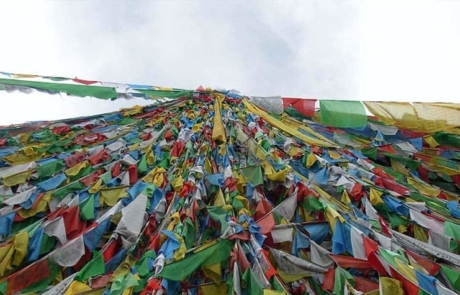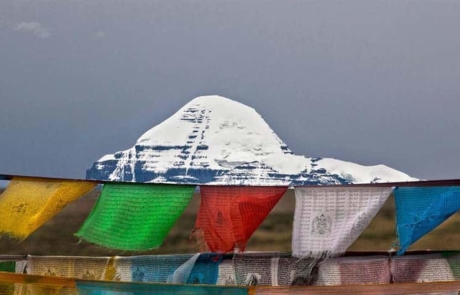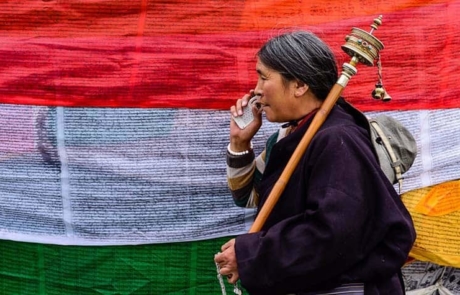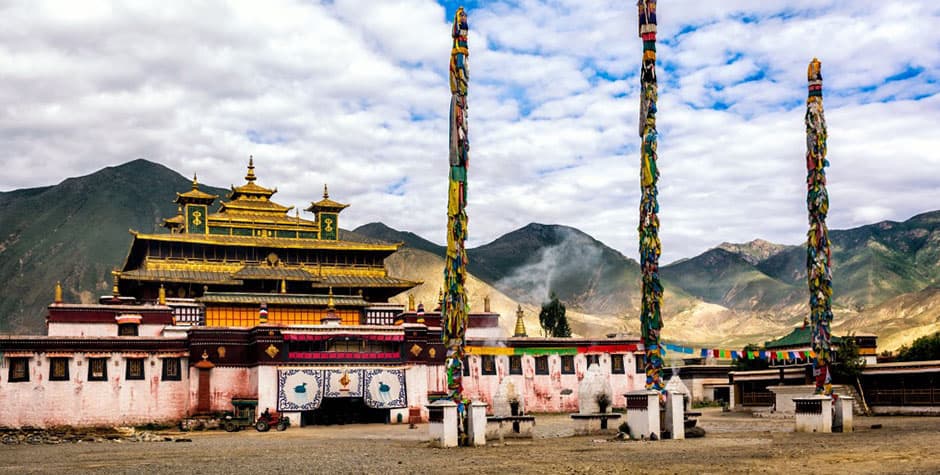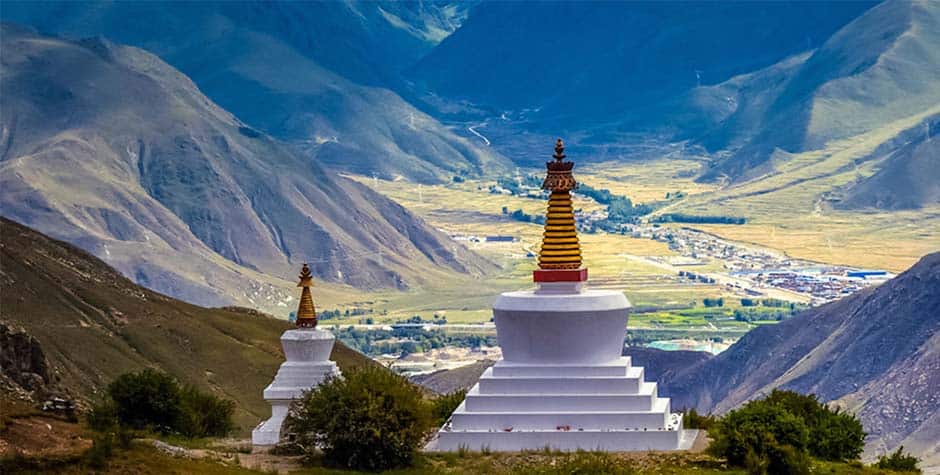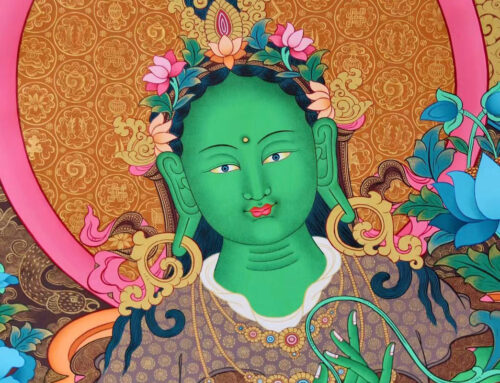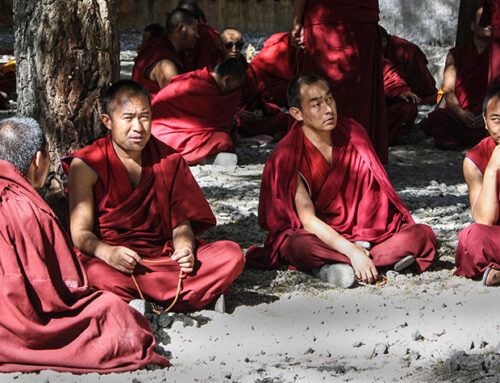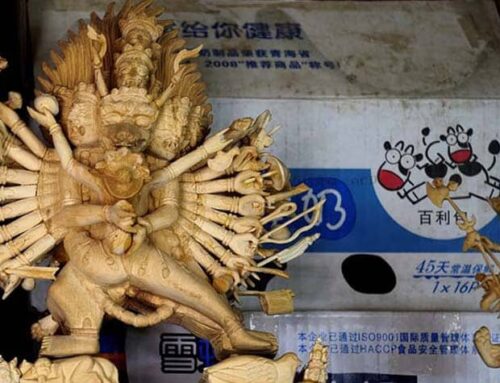The Tibetan prayer flag is used to promote peace, compassion, and wisdom. As you Travel in Tibet, the first and foremost welcoming sign you will see is a beautiful prayer flag, which we hang on our rooftops and at mountain passes. The flags are significant culturally and religiously important to us. Tibetan prayer flags feature inscriptions of auspicious symbols, Invocations, Sutras, and Mantras. This inscription aims to produce a spiritual vibration that is activated by the wind’s touch and carried to great distances. Whoever is touched by the wind will get uplifted and become a little happier because these small prayers dissolve in the wind and extend to all space, benefiting the entire universe.
The tradition of Prayer flags has a long and continuous history back to ancient India, Tibet, Persia, and China. Hence, this tradition is now becoming increasingly crucial for mountaineering communities and Neo-Buddhists around the globe. The meaning of the script on the prayer flag and symbols is indeed based on the most profound Buddhist philosophy.
The word for prayer flag in Tibetan is Dhar Cho. Dhar means ‘to increase,’ referring to the increase of life, fortune, health, and wealth, and Cho means ‘all sentient beings.’ This simple device is correlated with wind energy, harmonizing the environment and bringing happiness and prosperity to all living beings.
Tibetan prayer flag is used to promote peace, compassion, and wisdom. As you Travel in Tibet, the first and foremost welcoming signs you would see in Tibet is a beautiful prayer flag. which we hang on our rooftop and the mountain pass. The flags are a very important cultural and religiously important to us. Tibetan prayer flags have inscriptions of auspicious symbols, Invocation, Sutra, and Mantras. This inscription believes in producing a spiritual vibration that is activated on the touch of the wind and carried on to the high distance. Whoever will be touch by the wind will get uplifted and become a little happier. Because these small prayers dissolved in the wind and extend to all space and benefit the entire sentence being.
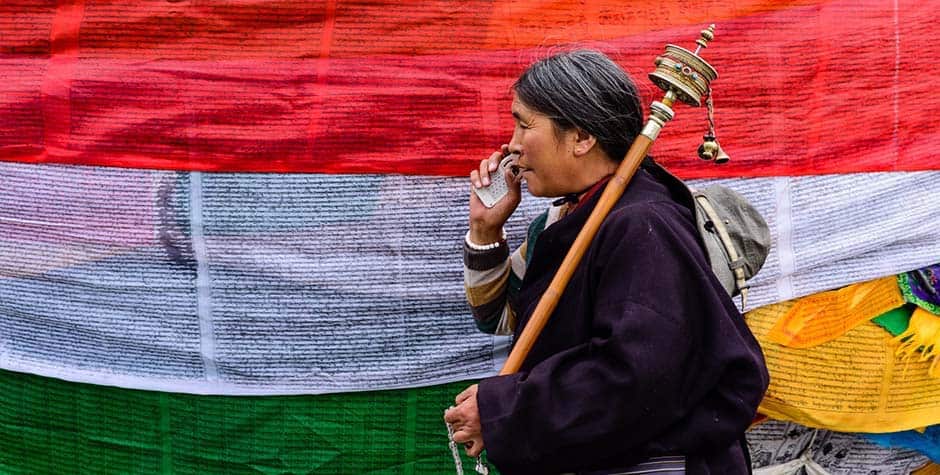
History of Tibetan prayer flag
Several theories exist about the origin of Tibetan prayer flags. Some say the customs of prayer flags originated in Nepal, while others claim they date back to Buddhist times. Many Tibetan scholars believe that the culture of Tibetan prayer flags originated during the pre-Buddhist era and was developed in-house.
Here is some theory we firmly believe. One approach suggests that the legend ascribes the origin of prayer flags to the Buddha himself, with his Prayer written on battle flags used by the devas against their adversaries. This tradition was later introduced in Tibet in 1040 with further modifications.
According to many Tibetan scholars, the origin of Prayer flags dates back to the pre-Buddhist era. TheBon priest would use five color flags for healing ceremonies. Each color represents a different element: space, air, fire, earth, and water, the fundamental building blocks of nature.
Colored flags help appease the local gods and spirits of streams, lakes, valleys, and mountains. When provoked, their elemental beings were thought to cause natural disasters and illness. Therefore, balancing the outer elements and propitiating the elemental spirits with offerings and rituals is the Bonpo way of calming nature and invoking the blessing of the gods.
During the 8th century, Tibetan King Trisong Detsen invited Guru Padmasambhava to Tibet to control the spiritual forces preventing the spread of the new religion. He bound the local spirits into an oath to become the protector deity, helping to spread and maintain Buddhism throughout the land of Tibet. He wrote many of the Prayer we use now.
Tibetan Prayer flag meaning:
These Tibetan Prayer flags are raised to spread blessings and prevent misfortunes. There are various types of prayer flags dedicated to different Buddhas and gods.
The Prayer flags Types.
Tibetan prayer flags can be categorized into two dozen types, half a dozen of which comprise the prayer flags we see nowadays.
Wind horse
(lung Ta) It is the most common kind of prayer flag, to the extent that many people think the word itself refers to this type of flag. The purpose is to raid the energy of the good fortune of the beings in the vicinity of the Prayer flag. In the middle of the flag, we have a pictural form of the wind horse carrying the three precious jewels. The four corners of the flags are always guard by the four great animals: the Garuda, the Dragon, the Tiger, and the Snow Lion. The Texts of the flags differ; the Victory Banner Sutra is the most popular.
Victorious Banners:
The Victorious Banner (the Sutra) is the most popular kind of prayer flag. This Sutra helps overcome obstacles and disturbances. Once, Buddha Shakyamuni gave the Sutra to Indra, the king of the god realm. The prayer flag is displayed in the Sutra alongside symbols such as the wind horse, Auspicious signs, Possessions of the Monarch, and a union of opposites. Special mantras are also added to increase harmony, health, wealth, and good fortune.
Health and longevity flags:
This flag typically features a condensed version of the Buddha's long life sutra, accompanied by a mantra and the Prayer of Long Life, as well as additional prayers. Amitayus, the Buddha of limitless life, is in the center, and the other two long-life deities White Tara and the Vijaya.
The Wish fulfilling prayer (Sampa Lhundrup):
Guru Padmasambhava wrote this Prayer. It is relevant to this modern age and suitable for protecting against war, famine, natural disasters, overcoming obstacles, and swiftly attaining one's wishes. This type of flag features Guru Rinpoche in the center, accompanied by repetitions of his mantra.
Praise to the 21 Taras:
Lord Atish translated this Sutra in the 11th century. The first of this prayer flag is an attribute to him. This flag usually depicts Green Tara in the middle and concludes with her mantra. Spreading the compassionate blessing is the primary purpose of the flag.
ther popular types of Tibetan prayer flags include the Avalokiteshvara – Bodhisattva of Compassion, the Warrior-King Gesar, the White Umbrella for Protection, the Kurukulle Power Flag, Manjushri - Embodiment of Wisdom, Milarepa – the Yogisaint, and the Vast Luck Flag.
The Significance of Colors and Elements:
five colors for tibet prayer flags
How we make Prayer flag:
The craft of making Tibetan prayer flags has evolved along with technological advancements. Initially, Tibetan monks wrote the prayer flags by hand using colored cloth. Later, with the introduction of wooden block printing. For many centuries, we have printed prayer flags using woodblock printing for more accuracy and durability.
The method of making a Prayer flag using a wooden block is still most preferred due to its durability after posting. However, with the advancement of easy screen printing, many of us often use prayer flags printed using this method.
After each flag is printed, we will stitch it together on a nylon rope for longevity. The order of the prayer flags is: first, blue, then white, red, green, and yellow.
Hanging Prayer Flags: Customs and Beliefs - Nurturing a Tradition
We put up the Tibetan Prayer flags only during the astrologically positive days—the days that have good energy. You will also see many of us putting it up during religious festivals, such as the Saga Dawa festival or the third day of the Tibetan New Year.
The travelers' guide to Tibetan prayer flag:
It is one of the things to do in Tibet while you are in Traveling to Tibet. We have always encouraged our clients to purchase prayer flags and attempt to display them on mountain passes, such as those near Mount Kailash and Mount Everest Base Camp. We hope you like my post about Tibetan prayer flags. If you do, please share and like this post. If you would like to read more about topics related to Tibetan prayer flags, Tibetan religion, and culture, click here to learn more about the Prayer flag on Wikipedia.
During your tours to Tibet, please remember to distribute prayer flags at high mountain passes during your Tibet tour.
Read more about Tibet Travel Information and Tibet Tours.

Tenzin Travel is the best Tibetan Travel agency in Tibet. Our agency is one of Tibet’s most experienced tour operators, with over 20 years in the industry. Founded by a local Tibetan family with decades of expertise as guides, managers, and route planners. We craft personalized itineraries for every traveler. Our agency is the highest-rated and most recommended Tibet travel agency on TripAdvisor, Google, and Lonely Planet.
We can make holistic arrangements for your trip to Tibet. Including a Tibet Travel Permit, a Tibetan tour guide, flight tickets, train tickets, vehicle arrangements, and hotel bookings in Tibet.
Our Lhasa office is just steps from Barkhor Square. All our Tibetan team ensures deep cultural, linguistic, and religious insights, setting us apart from other agencies.
Beyond tourism, we support Tibetan communities by donating a portion of each tour to local projects. Your travel to Tibet is about more than profit—it’s about the opportunity for us to give back.

